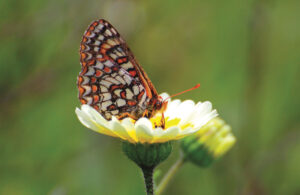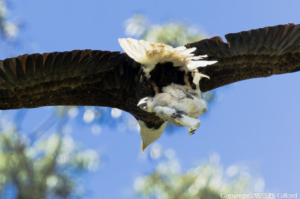As summer turns to fall, thousands of shorebirds return to the shoreline and mudflats of San Francisco Bay, either for a pit stop on their way south or to stay for the winter. Sometimes many different kinds gather in one place. How can you tell them apart? Watch for a little while and you can begin to sort them out by size and shape, by where they stand and, most of all, by their bills and how they use them.
Those bills have something else to teach us: There are a lot of critters hiding along the shore, and each bird has a bill fit to catch some of them for lunch.
As the tide goes out, long-legged marbled godwits, with upturned, mostly pinkish bills, will be in the water, so impatient to feed that they sometimes plunge their entire bill and head underwater as they probe the mud for worms, shrimp, and other creatures. The godwits probe, take two or three strides, and probe again. They use their long, sensitive bills to grab anything that feels like food. They’ve been seen grabbing 50 food items in a minute, but they drop about 20 percent of what they catch.
Another long-legged shallow-water feeder is the American avocet, whose trademark behavior is a sweeping motion of its upcurved bill as it walks forward, filtering tiny shrimp and even small fish. The bill–more curved on females, less on males–“cuts” like a scythe through water easier than a straight bill would, and can shut faster on its prey.
As the ebbing tide uncovers more of the mudflat, dowitchers and willets arrive. Dowitchers have long, straight, sturdy bills that they use to probe deeply in a “stitching” rhythm as they step across the wet mud. The sensitive tip of their upper bill is movable, to grasp food. Being able to move just the tip to grab a worm or mole crab makes it easier to feed in mud: Imagine trying to open that entire bill against the pressure of thick mud! This sensitive, movable tip is particularly noticeable on the extremely long bill of the well-named long-billed curlew, the largest of our shorebirds. Its downcurved tool can be almost as long as the bird’s body (nearly nine inches in the female). Why would it have such a long bill? For reaching deep into the mud to catch food other birds can’t reach. The curlew feeds alone probably because it needs more “elbow room” for its big, bent bill.
Dunlins, with their much shorter, slightly downcurved black bills, are usually seen in groups and in winter can sometimes be the most abundant shorebird in view. During the day, they hunt by sight, picking up small invertebrates from the surface of wet mud. They also probe, with a rapid stitching motion (several times per second). Such a “switch-hitting” strategy comes in handy at night.
We are lucky to live near San Francisco Bay, the most important wintering area for shorebirds in the western United States, with so many places where we can see them. And since shorebirds are faithful to their wintering grounds, you could be seeing the same birds at your favorite (and their favorite) spots, year after year. Notice where the birds take a stand, observe their style, and always check the bill!
Get Out!
From the Richmond shoreline to Hayward, from Richardson Bay to Heron’s Head Park to the Palo Alto Baylands, there are good shorebird watching spots all around the Bay. These parks make for family-friendly bird-watching, and you can always count on seeing birds in winter. (Download a helpful “Birding the Bay Trail” brochure [1.3 MB PDF].)
Even better, attend a beginning birding workshop at the Don Edwards National Wildlife Refuge’s Alviso Environmental Education Center [October 17 and November 21, 9-11:30 a.m.; or November 15, 9:30-11:15 a.m.; info: (408)262-5513]. Or check out the shorebird walk at Santa Clara Valley Audubon’s 18th annual Wildlife Education Day in Cupertino on October 24 [walk at 8 a.m., event 10 a.m.-2 p.m. Details and walk RSVP: (408)252-3740 or www.scvas.org]. On December 5, Richardson Bay Audubon is welcoming winter birds with a family-friendly tour at its Marin sanctuary [8:30 a.m.-10:30 a.m., $10 adult/$5 child. RSVP: (415)388-2524]. If your biggest challenge is getting the kids to take out their earbuds, go with the flow and download the wetlands podcasts from yourwetlands.org. These audio shows cover great birding areas in the South Bay salt ponds and along Highway 37 in the North Bay. [Dan Rademacher]




